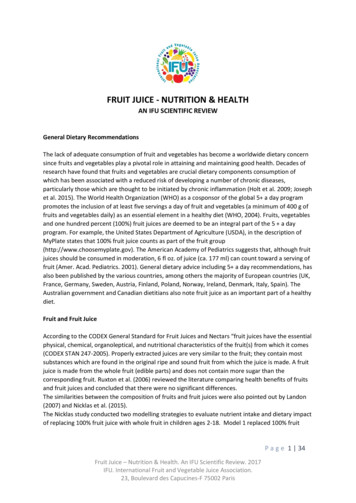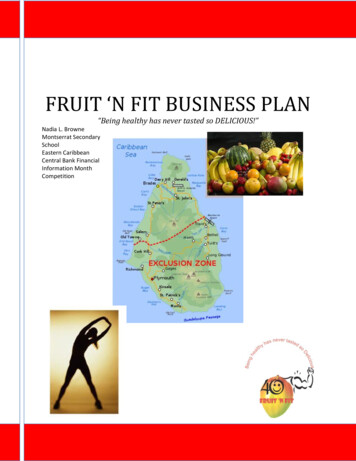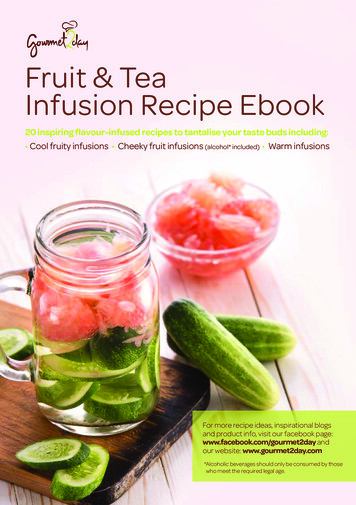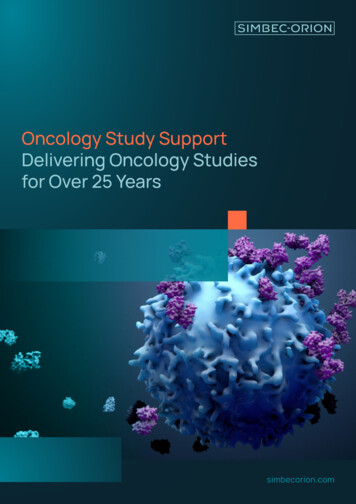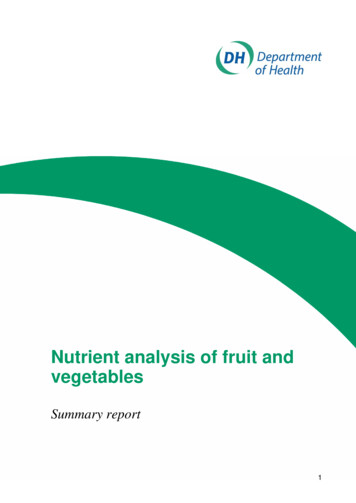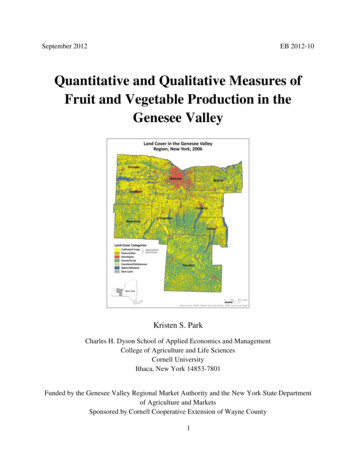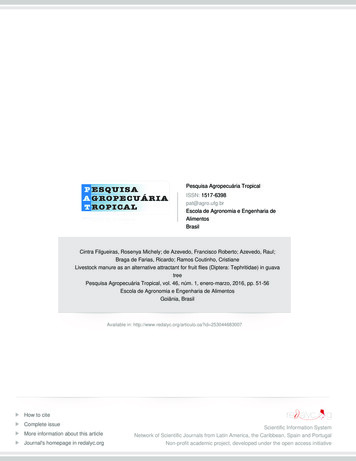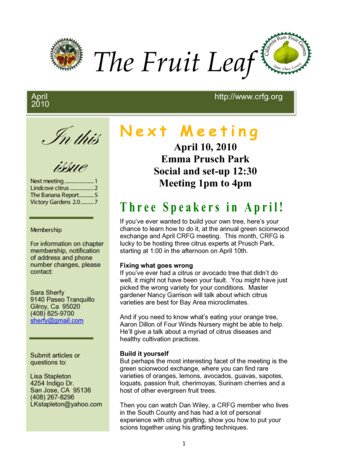
Transcription
The Fruit LeaffApril2010In thisissueNext meeting . 1Lindcove citrus . 2The Banana Report. 5Victory Gardens 2.0 . 7MembershipFor information on chaptermembership, notificationof address and phonenumber changes, pleasecontact:Sara Sherfy9140 Paseo TranquilloGilroy, Ca 95020(408) 825-9700sherfy@gmail.comSubmit articles orquestions to:Lisa Stapleton4254 Indigo Dr.San Jose, CA 95136(408) xt MeetingApril 10, 2010Emma Prusch ParkSocial and set-up 12:30Meeting 1pm to 4pmThree Speakers in April!If you’ve ever wanted to build your own tree, here’s yourchance to learn how to do it, at the annual green scionwoodexchange and April CRFG meeting. This month, CRFG islucky to be hosting three citrus experts at Prusch Park,starting at 1:00 in the afternoon on April 10th.Fixing what goes wrongIf you’ve ever had a citrus or avocado tree that didn’t dowell, it might not have been your fault. You might have justpicked the wrong variety for your conditions. Mastergardener Nancy Garrison will talk about which citrusvarieties are best for Bay Area microclimates.And if you need to know what’s eating your orange tree,Aaron Dillon of Four Winds Nursery might be able to help.He’ll give a talk about a myriad of citrus diseases andhealthy cultivation practices.Build it yourselfBut perhaps the most interesting facet of the meeting is thegreen scionwood exchange, where you can find rarevarieties of oranges, lemons, avocados, guavas, sapotes,loquats, passion fruit, cherimoyas, Surinam cherries and ahost of other evergreen fruit trees.Then you can watch Dan Wiley, a CRFG member who livesin the South County and has had a lot of personalexperience with citrus grafting, show you how to put yourscions together using his grafting techniques.1
Lindcove Fun and Takeaways: Why BO is Better than TBby Victoria Tran SoodIt was time to play and time to learn on the sunny, cool Saturday morning of January 16, 2010. I, along with tenother members of the Santa Clara Chapter, joined 35-40 other CRFG fellows and fruit enthusiasts at theUniversity of California Lindcove Research and Extension Center in Exeter, California to taste and pick ourfavorite citruses for two hours.The rules were simple: 1) use only hands to remove fruits from trees---no cutting devices such as knives orscissors of any kind; 2) get out when time is up.We met at the prep talk room at 10 am. While waiting for the talk to begin, Sini Falkowski, a walkingencyclopedia on fruits, explained the myth and facts about the effects that pummelos and grapefruits can haveon certain cholesterol medications. (Some people who have combined certain statins with these fruits or theirjuices have had severe side effects, including kidney failure.) See the following URLs for more information:* http://chemgroups.ucdavis.edu/ shaw/CHE 150 2008/DHC-Website/Bergamottin MurphyJ.pdf* efruitstat.htmwww* d-grapefruit.htmlThe prep talk was succinct. At the end of the talk we were given a map that would lead us to each of the 180varieties, and were immediately led to the demonstration block.I was fortunate to join up with Dan Willey, who let me shadow him. Dan and I then met up with Nancy Garrison,another walking encyclopedia on fruits. Nancy moved swiftly through the varieties and Dan and I could notkeep up, so we were on our own.Dan glanced at the map and within few seconds he found our bearings, and strategized a route to his targetedvarieties. Here’s what we found:* We started with the kumquats: The W. Murcot mandarin, Indio mandarinquat, Nordman seedlesskumquat, and Nagami. Nagami was too sour for my liking. The others were okay—nothing spectacular—butI picked some anyway.* Dan reminisced about the sweet lemon juice in India that had no added sweetener; the sweetness came fromthe lemon. To quench Dan’s curiosity about sweet lemons, we tasted the Millsweet lemon and Mary Ellensweet lime. Both fruits were bland and had little flavor. We thought the fruits might be better for juicing, so wepicked a few.* Some of the mandarins were delicious but nothing to write home about. The Satsuma mandarins—China Sseries (S-1, etc.), Miho Wase Satsuma, Xie Shan Satsuma—lacked flavor and sweetness. The SRA 92Clementine also had room for improvement. Dan said the Pixie at Riverside tasted better.* The Gold Nugget, Honey Mandarin, and Nuts Clementine were tasty but not exciting. If I had to choose afavorite, the prize would go to Gold Nugget.2
* The Reinking pummelo had thick, rough looking skin, conical shape, and was juicy and sweet but nothingspectacular. The Cocktail pummelo hybrid had a subtle flavor and was slightly sweet.* The Oroblanco grapefruit tasted like a pummelo, had a blooming flower fragrance, rich flavor, tender texture,and was juicy, subtly sweet, seedless. The seeds were so small that they did not interfere with easy eating.* The Chandler pummelos had a pinkish color with large seeds. In the field, Chandler pummelo was moreflavorful than the Oroblanco. When I tasted them at home, the Oroblanco was superior in taste and texture.Maybe the Chandler I tasted at home was not ready.* The Cara Cara navel oranges looked beautiful and tasted decent but was not sweet. A more knowledgeablefruit enthusiast named Dick told us the Cara Cara was not ready.* The Tarocco Blood (TB) oranges juicy and had tender texture with subtle sweetness; it would be great forjuicing.* The Moro blood orange had a beautiful color, nice texture and subtle sweetness.* The Boukhobza orange (BO) looked like blood orange and was very sweet with slight tartness. I wouldrather have BO over TB any day. (Sorry for the fruit pun.)About fifteen minutes after noon, we received a car horn signal that we needed to get out of the demonstrationblock and head back to the prep talk room. My prize after two hours in the demonstration block was two fulltrash bags of 24 varieties of citrus.We regrouped at the prep room for a light lunch. Afterwards, around 10 people went to the post party at Martinand Eva Bergheuis’ home. Martin went out of his way to show us the citrus varieties not available in thedemonstration block at Lindcove.* At Martin’s garden I found my favorite kumquat, Fukushu; the peel was thick and sweet (yes, sweet with nobitter taste) and had perfume fragrance that does not overwhelm your senses, but the juice sac (I learned thisscientific term from the Internet) was too sour for eating as a snack.* Shamouti orange was a treat, juicy and sweet.* Most impressive to me was the Yuzu orange, whose fragrance refreshed and rejuvenated your senses.* Martin also showed us his exotic fruit trees: hog plum, Monstera deliciosa (I could not appreciate this fruit),Gotu Kola, jujube, and guava. I had to drive back to the Bay Area, so I bid farewell before the tour ended.* Martin’s Cocktail grapefruit looked different from the one at Lindcove. Martin’s Cocktail resembled a largeorange, while the one at Lindcove resembled a pummelo.* The Thong Dee pummelo at Martin’s farm was delicious, sweet and dripping juicy. When I tasted the ThongDee at Martin’s garden, I was convinced that Thong Dee was the best pummelo I had tasted so far. But whenI tasted the Thong Dee and Oroblanco at home, Oroblanco outperformed the Thong Dee. Perhaps theThong Dee I tasted at home was not ready. For now, the Oroblanco is my favorite pummelo.3
4
The Banana Report—From Fremont and San JoseBy Lisa StapletonLast winter, I wrote about new advances in growing bananas in cold climates. also promised updates “later.”Well, it’s now later, the winter is over, and it’s time to assess which bananas made it through the winter with theleast damage. I’d planted as many of the most cold-hardy bananas I could find, from Joe Real’s cold-hardy list,available on the cold-hardy forum at bananas.org. Joe had observed which of his 85 different varieties ofbananas made it through the winter outside, in Davis, Calif., and ranked them from most cold hardy to least,based on damage sustained, as follows: California Gold (most cold hardy) Thousand Fingers Monkey Fingers Orinoco Brazilian Golden Rhinohorn Dwarf Orinoco Dwarf Brazilian Misi Luki Mysore Namwah Rajah Puri (best tasting but often “chokes”) Manzano Ice Cream Gold Finger Dwarf Namwah Sweetheart (FHIA 3, best tasting cavendish, cold hadiest among the cavendish types) Namwah Pearl Praying Hands Saba Cardaba Williams Belle*ValeryDuring the worst freeze, in December, I pulled a few of the plants inside, but they were otherwise left in 24-inchpots on our upstairs balcony, which is about 175 square feet, located over our insulated garage.They don’t get as cold there as they would if they were permanently planted in the garden. Even so, I had fouryoung Dwarf Cavendish plants, and every single one shriveled back and appears to have rotted. Other plants,such as Super Dwarf and Kandarian died back, but their roots felt firm, and they are coming back, sending outfresh green growth in early March. Gold Finger, Lady Finger, Thousand Fingers, Monkey Fingers andSaba got by with minimal damage, just a little leaf browning on a few leaves. But the real “stars” were DwarfOrinoco and California Gold. They quit growing from December through February, but that’s all. They areextremely cold hardy, with California Gold perhaps staying a little bit greener and resuming growth a bit earlierthan Dwarf Orinoco.Of course, my bananas are still quite young; except for Dwarf Orinoco, they just survived their first winter.Dwarf Orinoco has survived two. So there was a point before they started to push again when I was feelingkind of low. You know the feeling. You’ve got a lot of young trees that have been in the dirt a year or two, and apart of you thinks that you’ll never see fruit from those trees.5
This year, though, visiting a Fremont garden of one of our members, Bill Merrill, “cured” me. He had severalhuge stands of bananas—maybe taking up about a 200-square-foot patch—planted in the dirt in the middle ofhis yard. They were all Sweetheart, Ice Cream, and Orinoco, and while they’d had some leaf damage, theyhad more than a half dozen huge bunches of bananas. They also towered over the roof line. Bill says thatonce they got started, they had little frost damage. He says that he and his wife eat fresh bananas much of theyear.I left with a Sweetheart corm that must have weighed 40 pounds, a small Ice Cream plant in a five-gallon tub,and a renewed optimism that I’ll eventually harvest a crop half as good as Bill’s. Thanks, Bill.Fruit-tour tip: Bring extra bagsWhen I was at Lindcove, my small backpack became heavy and full with fruits. This was my first fruit pickingand I’d foolishly thought that a small dayhike backpack would be sufficient to carry the prize I picked.Fortunately, Dan was more experienced and had brought extra trash bags to rescue novices such as myself.Next time, I will be more prepared.6
Master Gardeners Victory Garden2.0 EventBy Lisa StapletonThe Master Gardeners of Santa Clara County will becelebrating Victory Garden 2.0, the annual Master GardenerSpring Garden Market, on Saturday, April 10, from 9:00 a.m. to2:00 p.m. at San Jose's History Center.!! ""# %&'"()*&") %"&,-%"day as our meeting. Maybe go early to their sale around 9:00, then scoot on over to our meeting by 1:00?)Spurred on by the grow-local movement and the most serious recession since the Great Depression,thousands of Bay Area residents have followed Michelle Obama's lead and started growing some of their ownproduce.!!But their best-laid plots often encounter the unexpected-varieties that don't perform well here, surprise visits frompests, and sometimes more work than anyone had countedon. That's why the Master Gardeners will also be holdingworkshops and mini how-to demonstrations at theupcoming event, which will feature sales of ornamentalplants and herbs, as well as food-bearing plants.!!Getting the most out of the sale!!* Be sure to bring something to protect your car's interiorfrom water and dirt.!!* If you are interested in saving seed from one year to thenext, ask for "open-pollinated seeds," "non-hybrids," or "seeds that breed true."!!* The Master Gardeners operate a "plant-check," similar toa coat-check, for plants that you've already purchased, sothat you don't have to haul them around while doing furthershopping.!!* After the show, if you need help, the Master Gardener'sWeb site has lots of articles, resources, videos, and eventelephone and email hotlines. Check outhttp://www.mastergardeners.org/scc.html.!!* Get there early, so you can get the best plant selection.Hundreds of people attend each year, so demand is usuallyhigh. "We got there toward the end of the plant sale oneyear, and there wasn't a lot left," says Loren Hart, whoattended a recent Master Gardener plant sale. "As one ofour family members is famous for saying, 'You have to get there early to get the best stuff, before the hoardersdo,'" he says.!7
BOARD OF DIRECTORS AND ACTIVITY MANAGERS 2010ProgramsMembershipE‐group tageOrchardSusan Kay408‐735‐7376scasnerkay@gmail.comSarah Sherfy408‐825‐9700sherfy@gmail.comPiyush Mehta510‐713‐8202piyush mehta@yahoo.comLisa Stapleton408‐267‐8296LKStapleton@yahoo.comKarl Gross408‐733‐5317gross karl@sbcglobal.netBecky Davies925‐556‐9846jefdavies@sbcglobal.netWalt ack KayKay639@yahoo.comVice‐chairKatie WongALIVENSILK@aol.comTreasurerJeffrey WongJeffrey.wong@itv.comSecretaryJoan Halperingargoyleden@verizon.netBoardMemberMilovan MilutinMilovan.milutin@comcast.netChris MemberMadeline Bakarichshootsandbranches@gmail.comNancy Garrison408‐298‐5828nancyg2@aol.comMilovan MilutinMilovan.milutin@comcast.netSpeaker GiftsKathleen Pylekathleenhp@aol.comPast ChairLibrarianWalt Compton650‐570‐5567Co‐librarianCRFG Santa Clara ValleyChapter9140 Paseo TranquilloGilroy CA 950208
3 * The Reinking pummelo had thick, rough looking skin, conical shape, and was juicy and sweet but nothing spectacular. The Cocktail pummelo hybrid had a subtle flavor and was slightly sweet. * The Oroblanco grapefruit tasted like a pummelo, had a blooming flower fragrance, rich flavor, tender texture, and was juicy, subtly sweet, seedless. The seeds were so small that they did not interfere .


